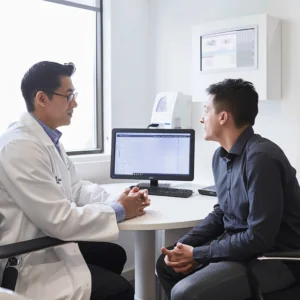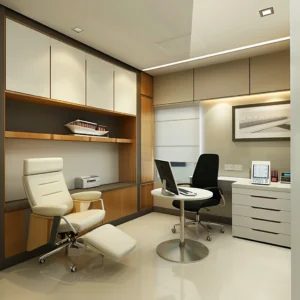Updated: 14 May, 2025
Does your doctor’s consultation room feel cold and impersonal? It might be affecting your communication! This blog post explores how the design of a consultation room can influence patient-doctor interaction, privacy, and even medical student training. I will provide tips to create a space that fosters trust and open communication, leading to a better healthcare experience.
Key Takeaways
- Consultation rooms should be designed to encourage open communication
- A round table with a shared screen can improve communication and establish a more collaborative patient-doctor relationship
- Adjustable lighting allows the doctor to change the ambiance depending on the situation
- The design should prioritise patient privacy
- Consider incorporating functionalities for medical student training, such as secure video recording of consultations for review and feedback
Why the consultation room design matters so much
Is the design of a doctor’s consultation room important? Definitely! A doctor’s consultation room is more than just a space for examinations and handing out prescriptions. It is the first introduction to an intimate relationship, during which patients express their health worries, anxieties, and weaknesses.
Imagine you’re walking into a doctor’s appointment. The first thing you notice is the size and feel of the room. Is it spacious or cramped, airy or confining, bright, or gloomy? This initial impression can influence how much you disclose to your doctor.
This concept is called “environmental design,” it goes beyond just paint colours and furniture. It’s about how the entire physical space of a healthcare setting can subtly influence patient behaviour and further impact self-disclosure, which is the most important factor during a consultation.
Space and Layout
Think about it this way: a small, cramped office might make you feel closed in and hesitant to share personal information. This could be due to a phenomenon called “reactance,” where you subconsciously resist feeling pressured to disclose. On the other hand, a larger, more open space could create a sense of freedom and encourage you to be more forthcoming.
This connection between physical space and communication isn’t a new idea. Research suggests our surroundings can influence our thinking. For example, a spacious room might make us feel more open and comfortable talking, while a cramped space could have the opposite effect. Similarly, the distance between you and your doctor can also matter. Studies show being closer together might lead to feeling more restricted and less likely to share sensitive information.
Budgeting is one of the main concerns in designing a doctor’s consultation room. Therefore our recommendation is to design it at least a size of 9㎡ to ensure the patient does not feel cramped in. This varies depending on the necessary equipment and furniture and it is important to keep in mind that there is a possibility of having the family or partner of the patient in the room at the same time. Further, it is beneficial for a similar reason to design the consultation room square-shaped. (focusplan)

Table Layout
If you feel disconnected from your doctor, the reason might be in the table layout. According to a new study, the design of the consultation room itself may be influencing outcomes. Researchers evaluated two layouts. First of all a typical configuration with an exam table and a computer operated by the doctor, and second of all a room with a round table and a shared laptop screen that both the patient and the doctor could use. The results are interesting! Patients in the round table group said they felt more relaxed and included while talking to their doctor, had easier access to information on the screen, and discussed that information with the doctor more frequently. While overall happiness and trust in the doctor were similar between groups, this study demonstrates that a simple change, such as a round table and shared screen, might improve communication and establish a more collaborative patient-doctor relationship.
Lighting and Ambiance
Lighting and ambiance also have to be considered when designing a consultation room. According to a study by Vanessa Okken, MS, simply increasing the brightness of the room can make it feel more spacious, leading to more open communication. Furniture layout and even wall texture can also play a role in how spacious a room feels.
Interestingly, the ideal ambiance might change depending on the situation. While brighter light may be helpful for anxious patients, a dimmer setting could be preferable for those receiving good news and therefore experiencing relief or happiness. Ideally, a doctor’s office would be able to adjust the atmosphere to suit the type of conversation taking place. Furthermore, a study by Kwallek in 1996 revealed that a white wall colour received the highest spaciousness scores, in comparison to darker colours such as green and red. Also not only a brighter wall colour but also a brighter ceiling colour increases perceived spaciousness.

Furnishings
Another Design aspect of your doctor consultation room is furnishing. Aside from aesthetics, the furniture and equipment of a doctor’s office are critical to both patient comfort and physician efficiency. Here’s how to achieve the ideal balance:
Doctors spend long hours examining patients. This is both physically and psychologically exhausting. To maintain quality consultations throughout the day it is recommended to invest in ergonomic seats and adjustable workstations to improve posture and reduce back problems in the long term. Furthermore, it’s recommended to choose comfortable chairs for the patient as well to make him feel good about sitting down. Consider slightly tilted seats for patients to create an environment where the patient is looking to have a conversation.
Built-in cabinets or strategically positioned shelves provide plenty of room for medical supplies and patient data without compromising floor space. The key is multi-functionality. Keep in mind to use separate safe storage for critical patient information.
Privacy by design
A doctor’s consultation room is a very sensitive place! Patients have to share private information they sometimes wouldn’t even share with their best friends. Therefore the consultation room has to provide a safe environment for patients to discuss sensitive health issues. Here are some suggestions for increasing patient privacy environment:
- Solid Doors preferably with a self-closing mechanism to prevent accidental interruptions or noise leakage.
- Curtains or screens, to separate examination areas, allowing patients to undress and dress in privacy.
- noise-canceling features or white noise machines might be necessary depending on the state of the walls to keep conversations secret and ensure patient confidentiality.
- blinds or frosted glass on windows helps to prevent outside views of the consultation room.
- implement secure data storage practices for patient records and electronic health information.
- Implement a cyber security plan which should include 2 Factor authentication on passwords, staff training on potential threats, and a protocol on what to do if a problem occurs
Patient-centred care
Medicine has been evolving over the years and recently patient-centred care seems to be the way forward. This not only requires a change of the competencies general practitioners need to learn during their studies but also how they design their consultation rooms. Patient-centred care focuses on effective communication. It requires the practitioners to be sure that they have effectively understood the patient’s needs in order to provide personalised care. A patient-centred approach is increasingly considered vital for doctors to offer high-quality care, to ensure the patient’s well-being, and to understand their situation through communication. This way, the patient understands their diagnosis and the treatment options available, allowing them to properly provide informed consent.
Optimise your consultation room for training
Whether you want to offer your current staff training or take in medical students, Videolab is the perfect software integration into your consultation room. With Videolab students can take videos via an app or a fixed camera setup that can be built into the consultation room. Preferably the camera is set up in a less intrusive way when designing the consultation room. If the camera is less “in your face” then people are less affected by it.
Then upload simulated consultations, peer consultations, or real patient consultations. The Videolab platform encrypts consultation videos at all stages of the process, and it allows for the recording of patient contacts in a GDPR-compliant manner. This allows the students to rewatch the video both alone and with a specialist to receive feedback and also importantly self reflect on the conversation.

